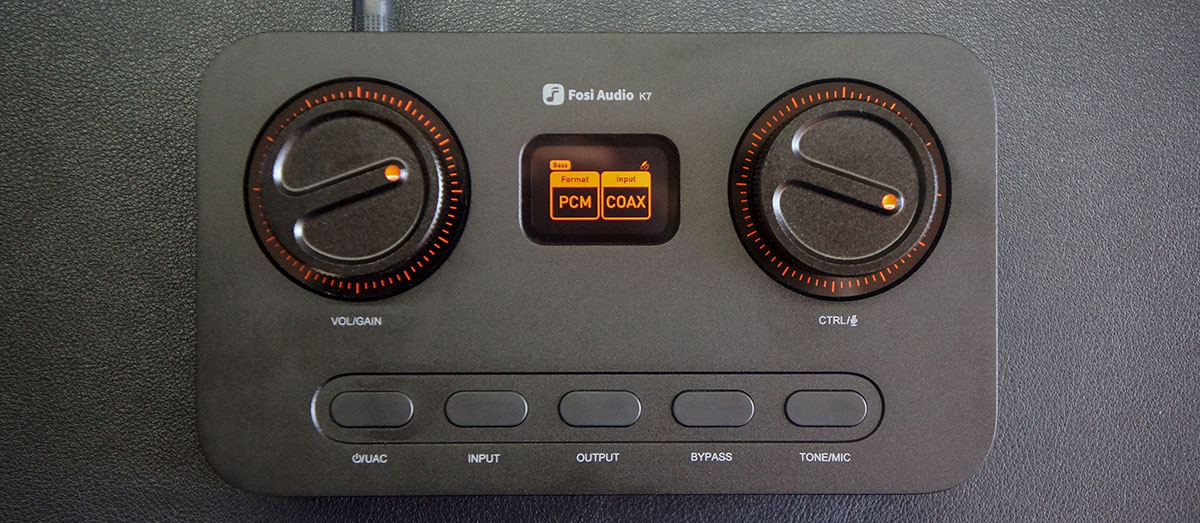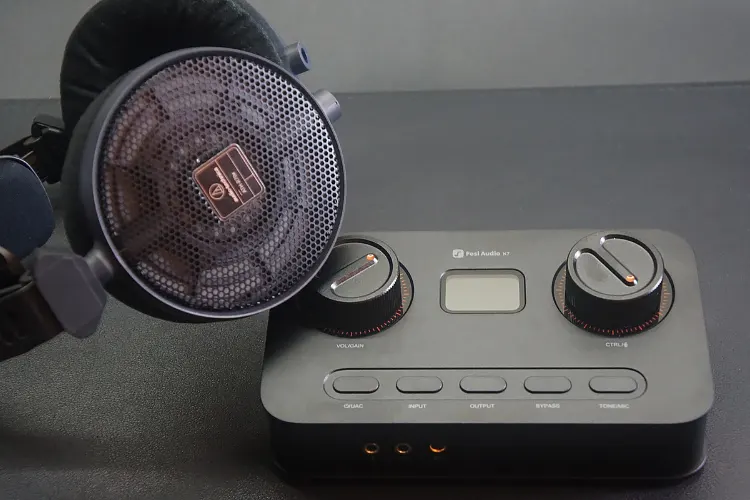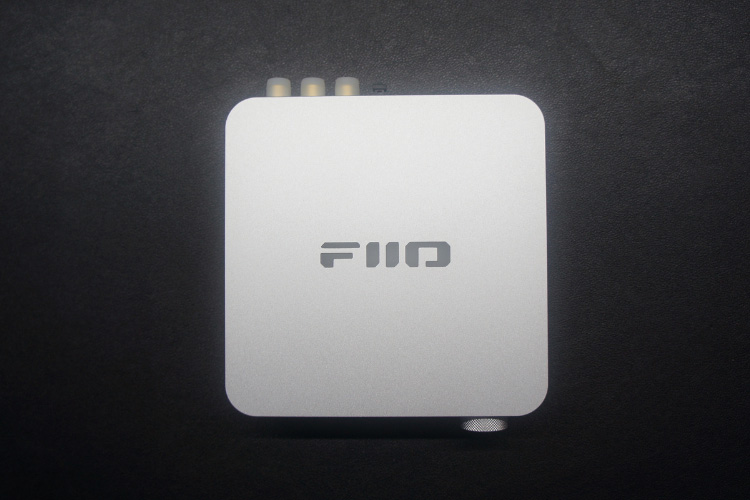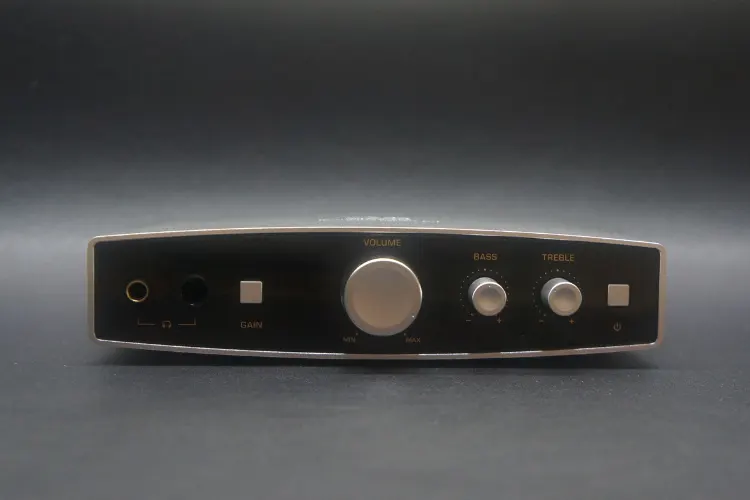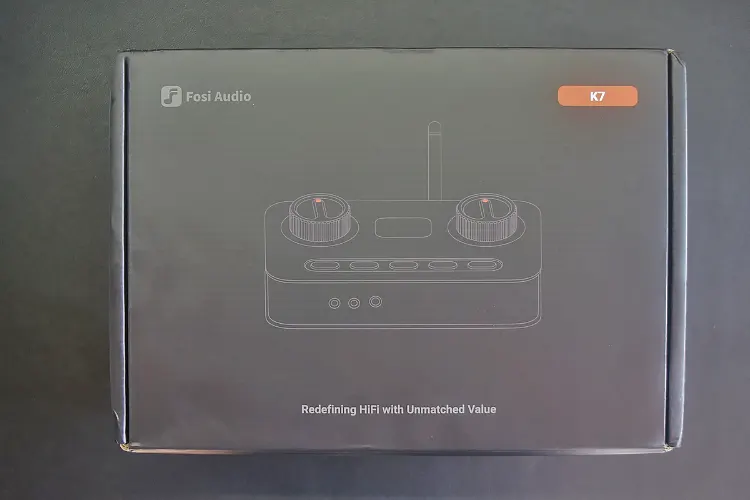Synergy
Power/Efficiency
For such a versatile unit, the Fosi Audio K7 can deliver impressive power output, especially via its 4.4mm balanced output headphone jack.
It can deliver up to 2.1W at 32Ω through its 4.4mm balanced output and 600mW at 32Ω via the 3.5mm single-ended output. This robust power output ensures that even demanding full-size headphones are driven effectively.
When paired with the K7’s BAL output, I was able to properly drive my Modhouse Argon MK3 to a listenable volume on high gain with the volume set to 56
Similarly, I was able to drive my less demanding Audio-Technica R70x via its 3.5mm SE output to a listenable level with the volume set to 45.
Pairings
The Fosi Audio K7 pairs best with headphones and IEMs that complement its clean and uncolored presentation, allowing their natural tonality to shine without excessive coloration.
I preferred the pairing with my Argon MK3, which retained its dark yet detailed signature while benefiting from the K7’s ample power.
The convenience of an all-in-one DAC/AMP with Bluetooth connectivity also meant I could enjoy Argons more often by streaming music from my phone.
With the Sennheiser HD 580 and Audio-Technica R70X, the K7 preserved its natural and balanced tonality. However, I preferred pairing these headphones with warmer sources to add richness to the mid-bass and lower mids while slightly smoothing out the treble.
For IEMs like the Yanyin Canon II, the K7’s Low gain mode provided a hiss-free listening experience while maintaining the strong imaging and fun tonality that matches my taste.
Select Comparisons
FiiO K11
Technical
The FiiO K11 is built around a Cirrus Logic CS43198 DAC, while the K7 employs an AKM AK4493SEQ DAC.
The K7 has the advantage in power output, pushing up to 2.1W @ 32Ω through its balanced 4.4mm output, significantly more than the K11’s 1.4W on a 32Ω load.
While both units provide a single-ended output (3.5mm for the K7 and 6.35mm for the K11) and balanced 4.4mm headphone output, only the K7 includes a microphone input, making it a more versatile option for gamers or streamers who need real-time mic monitoring.
Both devices feature USB, coaxial, and optical inputs, but the K7 wins in versatility with its inclusion of Bluetooth.
Design
Both units have an all-metal chassis but differ in their design philosophy. The K11 sports a modern, minimalist aesthetic, with a square profile, rounded edges, and a small knob at the front of the unit, complemented by its screen-based navigation.
In contrast, the K7 embraces a more classic DAC/AMP layout, featuring multiple knobs and switches for hands-on control.
Both units are well-built and designed to blend into any setup. However, the K7’s button and knob-based interface may appeal more to users who prefer tactile adjustments, while the K11’s sleek screen interface offers a more streamlined aesthetic.
Performance
The K7 delivers a more robust and dynamic presentation, with greater sub-bass depth and impact compared to the leaner low end of the K11. This results in a more powerful and engaging bass response, particularly in genres like EDM, hip-hop, and rock.
In the midrange, the K11 presents a cleaner and more analytical sound, favoring string instruments for clarity and vocal separation. The K7 has a slightly warmer tonality, lending more body to male vocals and instruments, giving it a more relaxing enveloping sound.
Treble performance is where the K11 slightly edges out the Fosi unit. Cymbals, chimes, and percussive elements sound more refined and detailed, with better air and separation in complex mixes.
The K7, while not lacking in treble clarity, has a smoother and more relaxed upper range, which may appeal more to those sensitive to brightness in high frequencies.
Shanling EH1
Technical
The Fosi Audio K7 and Shanling EH1 take different approaches to desktop DAC/AMP design. The K7 utilizes an AKM AK4493SEQ DAC, while the EH1 employs a Cirrus Logic CS43198 DAC.
The K7 has a significant edge over the EH1 in terms of their power output, delivering up to 2.1W @ 32Ω via its balanced 4.4mm output, compared to the EH1’s 1.015W on the same load.
This makes the K7 better suited for demanding headphones that require more power to reach their full potential.
Both units offer USB, coaxial, and optical inputs, however, only the K7 offers Bluetooth connectivity. Both units have tone controls, however, only the EH1 has independent hardware knobs for treble and bass.
The K7 lacks the dedicated control knobs but features a dedicated microphone input, making it a better choice for gamers and streamers.
Design
Both the Fosi Audio K7 and Shanling EH1 feature anodized aluminum chassis, offering a sleek and durable design that integrates well into any desktop setup.
The EH1 has a more compact, curved design with a large volume knob and dedicated bass/treble adjustment knobs for hands-on tonal control.
In comparison, the K7 has a top mounted control scheme, where the knobs, buttons and screen are faced up towards the user. This makes it easier to control the unit, but it doesn’t have the same sleek desk appearance as the EH1.
Performance
The EH1 has a neutral-warm tuning with a relaxed, slightly compressed presentation, making it a forgiving and smooth listen. It offers tight bass with a slight mid-bass emphasis, enhancing male vocals and synths, but lacks the power and depth needed for more demanding headphones.
The K7 provides a more dynamic and engaging sound, with deeper sub-bass, a clearer midrange, and better treble extension. Its higher power allows it to drive a wider range of headphones, making it a more versatile choice for audiophiles with multiple headphone pairings.
FiiO K11 R2R
Technical
The FiiO K11 R2R uses a 24-bit R2R DAC for a natural and analog-like sound signature, while the K7 employs an AKM AK4493SEQ DAC.
The K7 has a clear power advantage over the K11 R2R, delivering up to 2.1W @ 32Ω via its balanced 4.4mm output, compared to the K11 R2R’s 1.3W @ 32Ω balanced output.
On the single-ended side, the K11 R2R outputs 400mW @ 32Ω, while the K7 offers a more robust 600mW @ 32Ω, making it better suited for driving power-hungry headphones.
Both units feature USB, coaxial, and optical inputs, as well as balanced and single-ended headphone outputs. However, only the K7 supports Bluetooth.
Design
Both units feature anodized aluminum enclosures, providing a sleek and durable build that integrates seamlessly into any setup.
The K11 R2R has a compact, boxy design with rounded edges, resembling a mini-PC, while the K7 has a more traditional DAC/AMP form factor, featuring a top-facing volume knob and buttons.
The K11 R2R’s smaller screen placed in front of the unit gives it a modern and minimalist aesthetic, while the K7’s tactile knobs and dedicated controls offer a more hands-on approach to adjustments.
Performance
The K11 R2R caters to different sonic preferences, leaning toward a warmer, more analog sound with rich bass and a smooth midrange, ideal for listeners who enjoy a natural and relaxed presentation.
The K7 has a more neutral sound profile with a tighter sub-bass presentation and cleaner presentation of instruments in the midrange and treble with better detail.
My Verdict
At under $200, it’s hard to argue with the sheer value of the K7. Aside from offering more inputs and higher power outputs than its peers, it also comes with a microphone input geared toward streamers and gamers.
Its stock tuning may be a bit thin to some, and the bass control does not add as much mid-bass warmth as I would like. However, the ability to add your favorite full-sized headphones to a gaming set-up may be a worthy trade-off for most.
Audiophiles who are gamers, streamers, or WFH employees should give the K7 a listen. As a versatile all-in-one DAC/AMP with tuning flexibility, good power output, and mic input, it may be the ideal desktop solution for a lot of people.
Fosi Audio K7 Specifications
- DAC/AMP Chip: AKM AK4493SEQ/ TPA6120A2
- Output Power: 2.1W @ 32Ω (BAL), 600mW @ 32Ω (SE)
- Input(s): USB-C, Coaxial, Optical, Bluetooth, 3.5mm Mic In
- Output: 3.5mm SE, 4.4mm BAL, RCA,
- Playback USB: 32-bit/384kHz, DSD256

